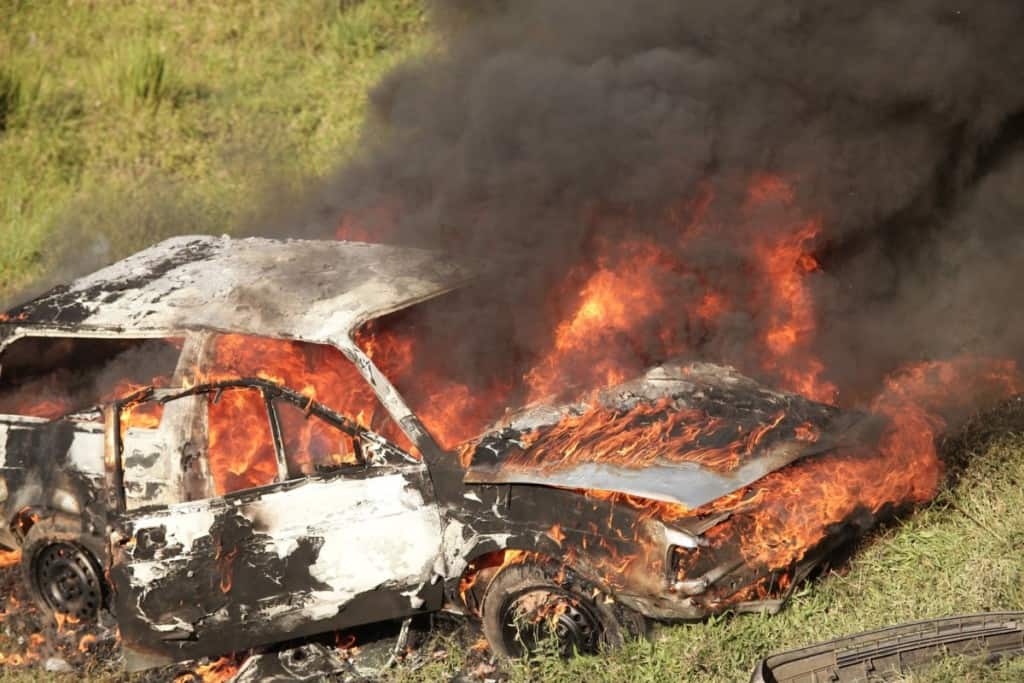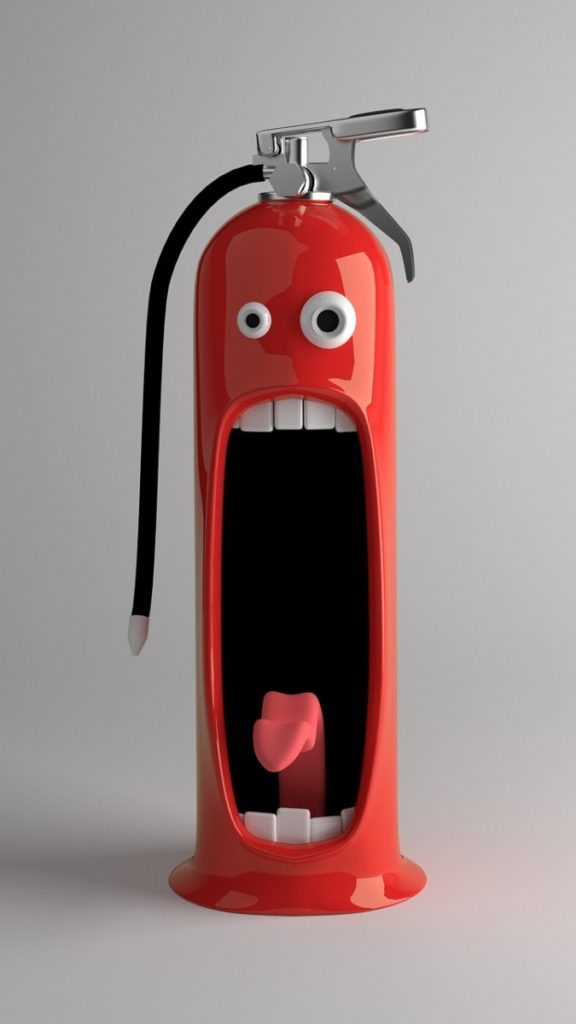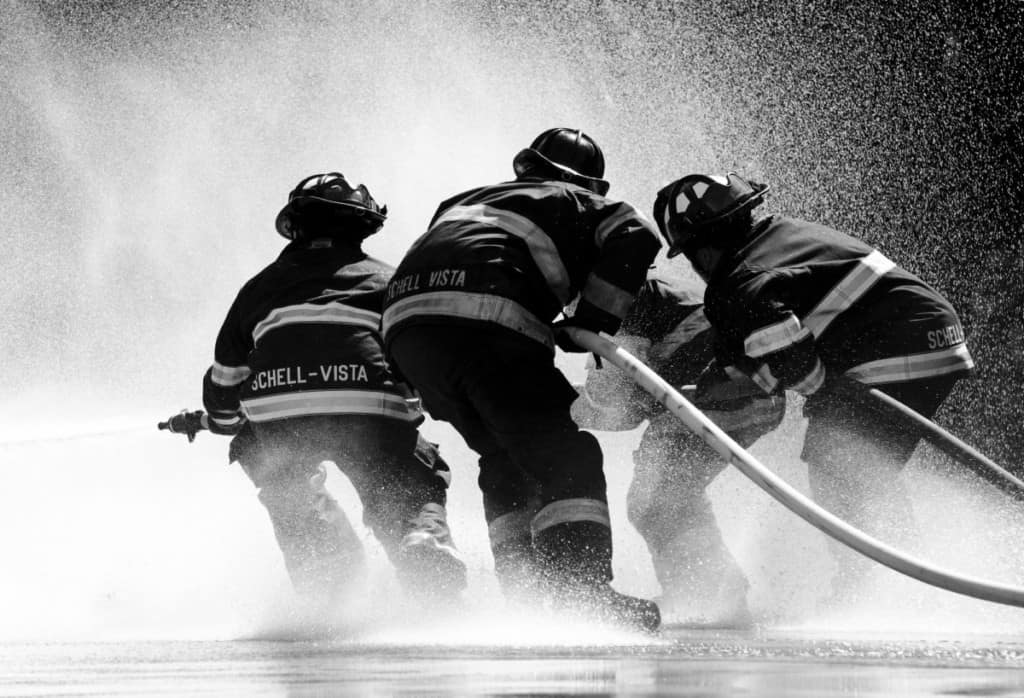While you hope to never need it, where and how you store your fire extinguisher is important. In the event that something does happen, you need your fire extinguisher to work properly and effectively. To ensure this is true, it is essential that you practice the best possible storage techniques.
According to the NFPA, fire extinguishers should be stored mounted to the wall at least 4 inches, but no more than 5 feet, from the floor. They need to be easily visible and accessible. They recommend 1 fire extinguisher per floor of the home, kept nearest to fire hazards like kitchens and garages.
These points, and a few of the most common questions associated with them, highlight some of the basic ideas behind storing a fire extinguisher. The answers vary a little, depending on your exact situation. In general, however, you will be okay if you store your fire extinguisher according to these guidelines.
After talking about the key tips for storing a fire extinguisher, I will give you a step-by-step guide to help you determine where and how to store your fire extinguisher(s).
Your # 1 priority is keeping your family safe. As a firefighter, I recommend everyone has updated smoke detectors that don’t require battery changes, like these ones from Kidde, a fire extinguisher, like this one from Amerex, and a fire escape ladder if you have bedrooms above the first floor, I recommend this one from Hausse.
To learn more about fire extinguisher and the other things that firefighters use, read: What Do Firefighters Use to Put Out Fires?
1. Can They Be Stored on its Side?
Most modern fire extinguishers are pressurized enough that it does not matter if you store them on their side or upright.
The best way to be sure, however, is to check the owner’s manual. A non-pressurized fire extinguisher will likely say that it must be stored upright.
Since nearly all fire extinguishers are pressurized, a fire extinguisher that isn’t might actually hint towards a different problem. Fire extinguishers can expire. If your fire extinguisher is not modern enough to be pressurized, it is likely that the extinguisher is already past its expiration date.
2. Can You Keep One in Your Car?

Most people will be able to store a fire extinguisher in their car. The only exception is due to extreme weather. Fire extinguishers can only be stored between -40 and 120 degrees Fahrenheit. For most people, this will not be a problem. If you happen to live in a cold climate (such as the Midwest) or a hot climate (like the Southwest), this might be a problem for you.
Car temperatures vary dramatically. In hot weather, especially, the temperature can become uncontrollable. While many people will never have to worry about this issue, those that do should be aware of this caveat in the advice to store a fire extinguisher in their car.
It is likely that nothing will happen if you forget to take a fire extinguisher out of a car on an unexpectedly hot or cold day. It isn’t likely that a fire extinguisher will explode or go off or cause any sort of external damage if the temperature in your car goes outside of the storage range. The fire extinguisher might not work, however, in the future if it was not stored at the proper temperature for any length of time.
My recommended fire extinguisher for your car: First Alert Car Fire Extinguisher AUTO5 with mount
Why Keep to One in Your Car
It is wise to keep a fire extinguisher in your car. Cars have motors and gas and all sorts of things that could start a fire. In an accident or motor malfunction, cars can catch fire. In the event that your car, or a car you come across, is on fire, a fire extinguisher in your car can make a big difference in the outcome.
Even if you do not need it for your car, it can be wise to carry one so that if you come across a situation that requires a fire extinguisher, you have on hand. For this reason, individuals who are interested in hiking and camping might find it particularly useful to carry a fire extinguisher with them.
If you camp by your car, enjoy bonfires on beaches or mountains, or otherwise enjoy a good campfire, store a fire extinguisher in your car (weather permitting) so that you have something on hand should these fires get out of hand.
3. Where to Store Them
Cars are just one spot where it is handy to carry a fire extinguisher. There are many locations around your house in particular, where fires are likely, and thus it is wise to store a fire extinguisher near.
My recommended fire extinguisher for general use in your home: Amerex 5 pound Class ABC Fire Extinguisher
A. The Kitchen
Kitchens are by far the most common places for fires in houses. The stove and oven both can cause fires. Grease is also common in kitchens and poses a fire hazard to your home. To protect against these concerns, keep a fire extinguisher nearby.
While it is always best to have a fire extinguisher handy, you might also consider storing a box of baking soda or flour near it. In case your fire extinguisher does not function properly, flour or baking soda can put out fires in the kitchen better than water.
Grease Fires in the Kitchen
Grease fires are the most common fire in the kitchen. These fires are dangerous because they burn hotter than most. You cannot put a grease fire out with water. Water will only make a grease fire more intense. A fire extinguisher in the kitchen is thus particularly necessary as water will only make the fire spread.
Here is a great video that shows what happens if you put water on a grease fire, as well as the proper way to extinguish it safely:
My recommended fire extinguisher for your Kitchen or other cooking equipment: Amerex 5 pound Purple K Class BC Fire Extinguisher
B. The Laundry Room
The laundry room also is a good place to store a fire extinguisher. While most fires will start in the kitchen, the laundry room is also a common location.
Dryers are a common starting point for fires in the laundry room. Keep a fire extinguisher within reach of your dryer as a result. To stay safe, always empty the lint trap to decrease the chances of a fire starting.
I recommend a general-use fire extinguisher near your laundry room. Here is a great choice: Amerex 5 pound Class ABC Fire Extinguisher
C. Garage/Workshop
Most garages and workshops house flammable materials. Store a fire extinguisher near these collections of flammable materials.
If your garage and workshop are not temperature controlled, consider whether your fire extinguisher will remain within the safe storage temperature range. If your garage will get colder than -40 degrees or over 120 degrees Fahrenheit, move your fire extinguisher somewhere easy to access that is temperature-controlled.
My recommended fire extinguisher for your garage or shop: Amerex 322, 5 pound Carbon Dioxide Class BC Fire Extinguisher
Also read: 6 Best Fire Extinguishers for Garage/Workshop/Welding Use
D. Heating Sources
Whether you have a furnace, radiator, or fireplace, anything that gives off heat is a potential fire hazard. Consider keeping a fire extinguisher near your heating sources so that should something happen, you are ready.
I recommend a general-use fire extinguisher near your heat sources. Here is a great choice: Amerex 5 pound Class ABC Fire Extinguisher
E. Grill or Fire Pit
If you have a grill or fire pit, it is important to store a fire extinguisher nearby. These items are particularly high risk since they often include open flames. Furthermore, if you grill, you will have the same issue with grease as the kitchen does. Therefore, storing a fire extinguisher not too far away is a wise call.
If you are worried about the temperature outside by your grill or fire pit, consider storing a moveable fire extinguisher in your garage so that you can take it out and set it nearby when you do plan to use your pit or grill.
My recommended fire extinguisher for your grill, fire pit or other cooking equipment: Amerex 5 pound Purple K Class BC Fire Extinguisher
For more information about the different types and how to use a fire extinguisher, see this article from the US Fire Administration.
4. Easy Access

When determining where to store your fire extinguisher, there are some common questions that you will need to address. How you answer them is up to you and will depend largely on the specifics of your house.
- Can a fire (starting at one of the potential fire hazards listed above) prevent you from reaching the fire extinguisher?
- Is the fire extinguisher within reach, regardless of which item is the source of the fire?
- Does anything else prevent you from accessing your fire extinguisher?
These questions will be addressed in the following subsections. The takeaway in general, however, is this: store your fire extinguishers in locations that are easy to access.
Also read: Do Fire Extinguishers Expire? How Long Do They Last?
A. Storage Distance
It is important to store a fire extinguisher near all of the locations listed above. Just how “near” they should be, though, is a serious question.
You do not want to store a fire extinguisher so close to a potential hazard that, should something happen, you need to reach through the fire to retrieve the extinguisher. This would defeat the point of storing the fire extinguisher at all.
To address this issue, it is recommended that fire extinguishers are stored about 30 feet away from the potential hazard. This means that if you have a small kitchen or tight laundry room, it can actually be safer to store a fire extinguisher in an adjoining room.
Keeping your fire extinguisher a little further from the potential fire hazard is also helpful because it means that you might be able to use one fire extinguisher for more than one hazard. Many laundry rooms, for example, also house the furnace. If this is true for you, you only need one fire extinguisher for that area.
B. Fire Extinguisher Dispersal
While you might not need a fire extinguisher for every fire hazard, you do need to store one on every floor. This is because, in the event of an emergency on one floor, you do not want to have to run up and down a flight of stairs to retrieve your fire extinguisher.
While the specifics of where you should store a fire extinguisher(s) will depend greatly on how big your house is, how many floors you have, and how many fire hazards you have, there is a general principle to keep in mind. Store fire extinguishers so that should something happen anywhere in your house, you have quick and easy access to putting it out.
Rule of Thumb
Quick and easy access requires you to follow two key principles.
- The storage spot should be visible and easy to remember.
- The storage spot should be easy to get to.
Many people tend to store fire extinguishers in the very back of cabinets. This makes them both hard to reach and hard to see. If you don’t see it, you might forget it.
So, I don’t recommend putting them in cabinets. Keep your fire extinguishers somewhere everyone will remember. Also, keep them somewhere that doesn’t require any rummaging.
You should be able to access a fire extinguisher within six seconds of a fire starting. Keep this in mind as you choose a location.
5. What Type Do You Have/Need?
For more information on the different types of fire extinguishers, see this article on femalifesafety.org.
Different fire extinguishers will have slightly different requirements. These differences will help you determine where and how to store that specific fire extinguisher.
While most fire extinguishers, for example, are pressurized and can thus be stored in any direction, a very small number are not. If yours is not pressurized, it must be stored upright. For these, getting some sort of mounting device will help ensure it is never knocked over and thus deactivated.
In the kitchen and around grease, it is important to have a fire extinguisher that will work around intense fires. Fire extinguishers you need for a grease fire are designated as “K class.” If the fire extinguisher in your kitchen is not of this specification, move it to a different location and purchase one that is for the kitchen.
Click here for a great Class K Fire Extinguisher for your Kitchen.

If you are not sure what fire extinguisher you have or will need, check out the US Fire administration’s guide. It breaks down what each class means and has a lot of helpful information on fire extinguisher use and storage.
The Fire Extinguisher Decision Guide
Based on the information above, here is a test you can perform to determine where and how to store your fire extinguisher(s) as well as help you figure out how many you need. To start, have something to take notes as you answer these questions around your house.
| 1. How many floors do you have? | For each floor, you will need at least one fire extinguisher. Repeat the following steps on each floor to determine where to store fire extinguishers on those floors. |
| 2. Is there a laundry room, kitchen, kitchen appliance, heating source, or other fire hazards on this floor? | If there is not, find an easy to access location that won’t be in your way for a fire extinguisher on that floor. If there are one or more fire hazards, proceed through questions 3-6 for each location. |
| 3. What potential storage site is 30 feet from this source? | It is recommended to store a fire extinguisher roughly 30 feet from a potential fire source. |
| 4. How quickly can you move from the fire hazard to this potential location? | Are there obstructions blocking your path? |
| 5. How quickly will you be able to retrieve a fire extinguisher from this location? | Can you get to the extinguisher in 6 seconds or less? |
| 6. Will you remember this as a location where you stored the fire extinguisher? | Easy to see and find? |
| 7. Do you have a garage, an outdoor area, or a car? | If no, skip to question 12. If yes, ask questions 8-11 for each item that you have. |
| 8. Will the temperature outside (or in the car) drop below -40 or go above 120 degrees? | If no, great! If yes, ask yourself if you will remember to move the fire extinguisher into temperature-controlled areas on those days. If you don’t find a location near the fire hazard(s), that will remain a consistent temperature. It’s not perfect, but it’s better than nothing. |
| 9. How quickly can you move from the fire hazard to this potential location? | Are there obstructions blocking your path? |
| 10. How quickly will you be able to retrieve a fire extinguisher from this location? | Can you get to the fire extinguisher in 6 seconds or less? |
| 11. Will you remember this as a location where you stored the fire extinguisher? | Easy to see and find? |
| 12. How many fire extinguishers will you need? (Minimum one for each floor) | Ask yourself questions 13 and 14 for each one. |
| 13. Is a grease fire likely here? | If yes, Buy a K class fire extinguisher here. |
| 14. Will you need to store the fire extinguisher on its side, or is there a chance it will be knocked over? | If yes, Buy a pressurized fire extinguisher here. |
What If It Is Expired?

If you already know where you need to store your fire extinguisher(s) but discover they are not fully charged/expired, you might have a few remaining questions. Fortunately, your local fire station can be a good resource in this situation. If you have an expired fire extinguisher or one that lacks a full charge, you may be able to bring it to your local fire station for safe disposal.
If the fire department can’t accept it in your area, bring your fire extinguisher to a hazardous waste disposal site.
Fire extinguishers are a powerful tool. They contain material that is not safe for consumption. To prevent any of these hazardous materials from leaching into groundwater or other vital sources, it is important you go through the proper steps to dispose of a fire extinguisher safely. Hazardous waste disposal sites are equipped to handle these concerns.
How To Get a Refill
To learn more about refilling fire extinguishers, read: Can a Fire Extinguisher Be Used More Than Once?
Fire extinguishers need to be recharged after every use and periodically throughout their life. You can ask your local fire department about this process, but it is usually done by a company certified to inspect and recharge fire extinguishers.
Since fire extinguishers contain hazardous materials, it is vital that only professionals handle this task. Though it varies, these services will usually recharge extinguishers for about $20-$30. Though sometimes it is more cost-effective to just replace the fire extinguisher after use rather than recharging it.
Recommendations:
For general use in your home: Amerex 5 pound Class ABC Fire Extinguisher
For your kitchen or other cooking equipment: Amerex 5 pound Purple K Class BC Fire Extinguisher
For your garage or shop: Amerex 322, 5 pound Carbon Dioxide Class BC Fire Extinguisher
For your car: First Alert Car Fire Extinguisher AUTO% with mount
Related Articles
Will a Fire Extinguisher Ruin an Oven?
Where Is The Best Place To Store A Fire Extinguisher On A Boat?

